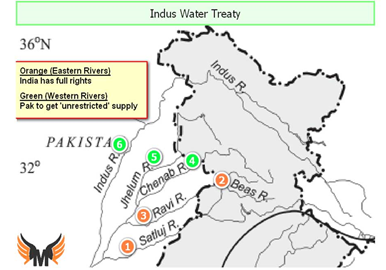

20th October 2022 (7 Topics)
Context
Recently, the argument aroused after the World Bank appointed Michel Lino as the ‘Neutral Expert’ and Prof. Sean Murphy as Chairman of the Court of Arbitration for dispute resolution against the debate of the Hydroelectric Project establishment between India and Pakistan as mentioned under the Indus Water Treaty.
About
River Indus: Geographic Location
- The Indus is a transboundary river of Asia and a trans-Himalayan river of South and Central Asia.
- The 3,120 km (1,940 mi) river rises in mountain springs northeast of Mount Kailash in Western Tibet, flows northwest through the disputed region of Kashmir, bends sharply to the left after the Nanga Parbat massif, and flows south-by-southwest through Pakistan, before emptying into the Arabian Sea near the port city of Karachi.
- Significance:
- The river has historically been important to many cultures of the region.
- The 3rd millennium BC saw the rise of the Indus Valley civilization, a major urban civilization of the Bronze Age.
- During the 2nd millennium BC, the Punjab region was mentioned in the Rigveda hymns as Sapta Sindhu and in the Avesta religious texts as Saptha Hindu (both terms meaning "seven rivers").

The Indus Water treaty, 1960
- The Indus system comprises of main Indus River, Jhelum, Chenab, Ravi, Beas, and Sutlej.
- The basin is mainly shared by India and Pakistan with a small share of China and Afghanistan.
- Under the treaty signed between India and Pakistan in 1960, all the waters of three rivers, namely Ravi, Sutlej, and Beas (Eastern Rivers) were allocated to India for exclusive use.
- While, the waters of Western rivers - Indus, Jhelum, and Chenab were allocated to Pakistan except for specified domestic, non-consumptive, and agricultural use permitted to India as provided in the Treaty.
- India has also been given the right to generate hydroelectricity through run-of-the-river (RoR) projects on the Western Rivers which, subject to specific criteria for design and operation is unrestricted.
What is the Dispute all about between India and Pakistan?
- Both countries held different positions when Pakistan raised objections regarding the technical design features of the Kishanganga (330MW) and Ratle (850 MW) hydroelectric power plants located on the tributaries of the Jhelum and the Chenab, respectively, designated as “Western Rivers”.
- However, under Articles III and VII of the treaty, India is permitted to construct hydroelectric power facilities on these rivers (subject to constraints specified in Annexures to the Treaty).
- Differences were also discernible when Pakistan approached the World Bank to facilitate the setting up of a court of arbitration to address the concerns related to these two projects referred to in Article IX Clause 5 of the treaty, and when India requested the appointment of a Neutral Expert referent to Clause 2.1 of Article IX on the settlement of differences and dispute of the treaty, respectively.
- Pakistan, invoking Article VII Clause 2 on future cooperation, raised objections on the construction and technical designs of the Pakal Dul and Lower Kalnai hydropower plants located on the Marusudar River, a tributary of the Chenab, in the Kishtwar district of Jammu and Kashmir.
- India has raised concerns on issues such as Pakistan’s blockade of the Fazilka drain, which resulted in water contamination in the border areas.
Recent Developments by India:
To stop the flow of the waters that belong to India for its utilization in India, the following steps have been taken:
- Shahpurkandi Project
- Construction of Ujh multipurpose project
- The 2nd Ravi Beas link below Ujh


